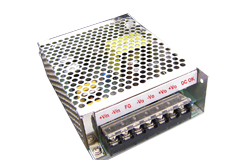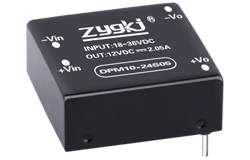nouvelles
Designing an Efficient Industrial AC-DC Converter
Auteur: Module d'alimentation ZYG Time: 2023-5-9
In modern industrial applications, AC-DC converters play a significant role in transforming electrical power between different voltage levels and frequencies. These converters are essential for powering a wide range of devices, from small electronic circuits to heavy machinery. With the increasing demand for more efficient and reliable power supplies, it is essential to design AC-DC converters that can meet the requirements of industrial applications.
The efficiency of an AC-DC converter is a critical factor that determines its performance. Higher efficiency means that less power is dissipated as heat, resulting in lower operating temperatures and longer device lifetimes. To achieve high efficiency, designers must consider several factors, including power factor correction, switching frequency, and topology.
Power factor correction (PFC) is a technique used to improve the efficiency of AC-DC converters. It involves controlling the input current to the converter to match the voltage waveform, reducing the harmonic distortion and improving the power factor. PFC can significantly improve the efficiency of AC-DC converters, reducing power losses and increasing the power factor.
Choosing the right switching frequency is also critical to achieving high efficiency. A higher switching frequency allows for smaller and lighter components, reducing the overall size and weight of the converter. However, a higher switching frequency also increases switching losses, reducing efficiency. Designers must find the optimal switching frequency that balances size and efficiency.

Topology is another factor that affects the efficiency of AC-DC converters. There are several topologies available, including flyback, forward, and push-pull. Each topology has its advantages and disadvantages, and designers must choose the best topology based on the application’s requirements. For example, the flyback topology is commonly used in low-power applications, while the forward topology is suitable for high-power applications.
In addition to these factors, designers must also consider other design aspects, such as component selection, control circuitry, and thermal management. Choosing the right components, such as high-quality capacitors and inductors, can significantly improve the converter’s efficiency. Control circuitry, such as pulse-width modulation (PWM) circuits, can help regulate the output voltage and improve efficiency. Thermal management is also essential, as it can help dissipate heat and prevent overheating.
In conclusion, designing an efficient industrial AC-DC converter requires careful consideration of several factors, including power factor correction, switching frequency, and topology. By optimizing these factors and considering other design aspects, designers can create high-performance and reliable AC-DC converters that meet the demands of modern industrial applications.
Précédent: Designing an AC-DC Converter Circuit: A Step-by-Step Guide
Prochain: AC-DC Converter Module: Efficient and Reliable Power Conversion Solution
les informations pertinentes
-
2023-10-11
Module Power Supply: Ensuring Efficient and Reliable Power Distribution
Introduction The demand for efficient and reliable power distribution is more crucial than ever. From data centers to industrial automation systems, module power supply plays a vital role in providing consistent and stable power to various components. This article aims to explore the importance of module power supply in ensuring efficient and reliable power distribution and its impact on different industries. Overview of Module Power Supply A module power supply, also known as a power module or power brick, is a device that converts one form of electrical power into another. It takes input power from a source and provides the required voltage, current, and frequency to the load. These power supplies are designed to be compact, lightweight, and easily...
Voir les détails -
2023-11-4
DC to DC Power Supply Module: Efficient and Reliable Solution for Voltage Conversion
Introduction: DC to DC power supply modules are electronic devices that convert one DC voltage level into another. They play a crucial role in various electronic systems, where different voltage levels are required for proper functioning. These modules are highly efficient and reliable, making them an essential component in industries like telecommunications, automotive, aerospace, and renewable energy. Efficiency of DC to DC Power Supply Module: One of the key advantages of using a DC to DC power supply module is its high efficiency. These modules are designed to operate with minimal power loss during the conversion process. Unlike traditional linear regulators, DC to DC power supply modules utilize switching techniques, such as pulse width modulation (PWM) or frequency modulation (FM),...
Voir les détails -
2023-8-3
High quality 24V AC to DC Converter: Efficient Power Conversion for Your Electronics
In today's increasingly digital world, electronics play a vital role in our daily lives. From smartphones and laptops to home appliances and automation systems, these devices require a stable and efficient power supply to function properly. This is where a 24V AC to DC converter comes into play, providing a reliable power conversion solution for various electronic applications. First and foremost, it is essential to understand the difference between AC (alternating current) and DC (direct current) power. AC power is the type of electricity supplied by the power grid, where the direction of current periodically changes. On the other hand, DC power flows in a constant direction, making it ideal for powering electronic devices. However, since most power sources, such...
Voir les détails -
2023-6-1
Industrial AC-DC Converter: Powering Your Operations with Efficient Electrical Solutions
An industrial AC-DC converter is a device that is used to convert alternating current (AC) power into direct current (DC) power. Such devices are commonly used in industrial settings where electrical power is required. AC power is the power that is supplied by the utility company or power grid, while DC power is the power that is used by most electronic devices like computers, smartphones, and other electronic devices. In today's world, electricity is an essential part of our lives and we cannot imagine living without it. It is an essential part of modern industrial operations and has become an essential resource for our daily lives. However, the quality of electricity that we receive varies from place to place and...
Voir les détails -
2023-6-18
Custom Type Power Series: The Ultimate Guide to Creating Unique and Effective Typography
Typography is a crucial aspect of graphic design. It's the art and technique of arranging type to make written language legible, readable, and appealing when displayed. Custom typography takes it a step further by creating unique and personalized typefaces that reflect the brand 's personality. In this guide, we'll explore the basics of typography, the benefits of custom typography, and the steps to create your own custom typeface. Typography Basics Typography has its own language with terms like serif, sans-serif, kerning, tracking, and leading. Let's break them down: - Serif: A small line or stroke attached to the end of a letter or symbol. - Sans-serif: A typeface that does not have serifs. - Kerning: The process of adjusting the...
Voir les détails -
2023-7-27
Understanding the Basics of AC-DC Power Supply: A Comprehensive Guide
Introduction In today's technological era, power supplies play a crucial role in various electronic devices and systems. In particular, the AC-DC power supply is an essential component that converts alternating current (AC) into direct current (DC) to provide a stable and regulated power source. This article aims to provide a comprehensive understanding of AC-DC power supplies, explaining their basic principles, components, and functionality. 1. The Basics of AC and DC Power To comprehend the functionality of an AC-DC power supply, it is essential to understand the difference between AC and DC power. Alternating current (AC) is the type of electricity that flows in both directions periodically. It is the power supplied by the utility grid and is characterized by a...
Voir les détails


















